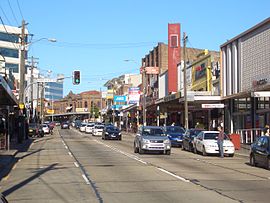 Sydney Translation Services provide fast and affordable, certified document translation services for the residents of Ashfield. Ashfield is a suburb in the Inner West of Sydney, in the state of New South Wales, Australia. Ashfield is about 9 kilometres south-west of the Sydney central business district.
Sydney Translation Services provide fast and affordable, certified document translation services for the residents of Ashfield. Ashfield is a suburb in the Inner West of Sydney, in the state of New South Wales, Australia. Ashfield is about 9 kilometres south-west of the Sydney central business district.
Ashfield’s population is highly multicultural. Its urban density is relatively high for Australia, with the majority of the area’s dwellings being a mixture of mainly post-war low-rise flats (apartment blocks) and Federation-era detached houses. Amongst these are a number of grand Victorian buildings that offer a hint of Ashfield’s rich cultural heritage.
Ashfield History
Aboriginal people
Prior to the arrival of Europeans, the area now known as Ashfield within a broader area Wangal people moved and lived, having migrated from South East Asia and then downwards. Exact numbers are unknown, some research indicates there was between 8000 and 10000 aboriginal people in the broader Sydney region, fluctuating with the seasons and tribal conflict. Their territory was believed to be centred on modern-day Concord and stretched east to the swampland of Long Cove Creek (now known as Hawthorne Canal). The land was heavily wooded at the time with tall eucalypts covering the higher ground and a variety of swampy trees along Iron Cove Creek. The people hunted by killing native animals and fish. Violence is known to have occurred both between tribes and within tribes, in particular towards women.
Early British settlement
By 1790, a rough track had been built between the colony’s two settlements at Sydney Cove and Parramatta. This route later became the main artery of the expanding Greater Sydney and, as the northern boundary of what is now Ashfield, dictated early British settlement in the area. The first land grant in the area was made to Rev Richard Johnson in 1793 and all of it had been granted by 1810. By the 1820s, all the grants had been amalgamated into two large estates: Ashfield Park (the northern half between Liverpool Rd and Parramatta Rd) and Canterbury Estate (the area south of Liverpool Rd). Ashfield Park was named by Robert Campbell, whose father was the laird of Ashfield in Scotland.
Population growth
In 1838, Elizabeth Underwood, then owner of Ashfield Park, subdivided part of her land to form the village of Ashfield between Liverpool Rd and Alt St. Part of the subdivision was the building of St John’s Church in Alt St in 1841. This is the oldest surviving building in Ashfield. By 1855, the village had about 70 houses and 200 residents. However, the opening of the Sydney-Parramatta railway line that year, with Ashfield as one of its six original stations, led to a population explosion. In 1872, there were enough residents for the area to be granted a municipal council. By 1890, the population had grown to 11,000.
During this time, Ashfield was seen as a highly desirable location compared to the city, which had become crowded and pestilent. Many grand Victorian houses were built in the latter part of the 19th century. But by the time of World War I, the suburb had fallen out of favour and the rich residents had mostly headed for the North Shore. Many of the grand homes were knocked down in the 1920s and 30s and replaced with small art deco blocks of flats or semi-detached houses. A few remain, however, and are listed in the Landmarks section.
By the 1950s, the population of Ashfield had begun to fall, as it had in many surrounding suburbs, as people moved to newer houses on larger blocks of land on the urban fringe. The Council’s response was to start approving large blocks of flats, many of which were built during the 1960s and 70s but which also continue to be built today. There is, however, recognition of the area’s heritage with many buildings in the suburb protected by heritage orders.
Ashfield Events
The major community event in Ashfield each year is the Carnival of Cultures, a celebration of the area’s multiculturalism. Held every year since 1996 in Ashfield Park, it includes performances, food stalls and children’s entertainment. In recent years, the Sydney Writers’ Festival has also held part of its program in Ashfield as part of the regular Authors at Ashfield series of talks.
Ashfield Demographics
In the 2011 census of Population and Housing, Ashfield had a population of 22,189 people, in an area of 3.5 square kilometres. The median age (35) was slightly younger than the national average (37) while the median household income ($1314 per week) was slightly better off than the national average but lower than the figure for the Greater Sydney region.
One area where Ashfield differed markedly from the national figures was in its ethnic mix. Australian born residents are a minority with only 41% of Ashfield residents being Australian-born. Foreigner birth were from 15% born in China and 6% born in India. A fifth of the population spoke a Chinese language at home (Mandarin 14% and Cantonese 6%).
The number of people professing no religion was (26%). Catholicism (25%) was the most common religion, followed by Hindus (9%), Buddhists (7%) and Anglicans (7%).
The other area where Ashfield differs is its housing. Of the 8,215 occupied private dwellings counted, 63% were flats (compared to the national figure of just 14%), 27% were detached houses, while 9% were semi-detached or attached houses. The high number of flats contributed to a higher than average number of people renting (46%) compared to houses owned outright (24%) or being purchased (26%).
Find translators – Westlake, Yeronga, Anstead, Auchenflower, Bardon
